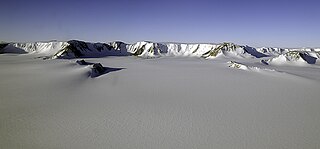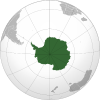Related Research Articles

The Shackleton Range is a mountain range in Antarctica. Rising at Holmes Summit to 1,875 metres (6,152 ft), it extends in an east–west direction for about 160 kilometres (99 mi) between the Slessor and Recovery glaciers.
The Dominion Range is a broad mountain range, about 48 km (30 mi) long, forming a prominent salient at the juncture of the Beardmore and Mill glaciers in Antarctica. The range is part of the Queen Maud Mountains
Shaler Cliffs is a rock cliffs 2 miles (3.2 km) east-southeast of Charpentier Pyramid, rising to 1,000 m in the north part of Herbert Mountains, Shackleton Range. Photographed from the air by the U.S. Navy, 1967, and surveyed by British Antarctic Survey (BAS), 1968–71. In association with the names of glacial geologists grouped in this area, named by the United Kingdom Antarctic Place-Names Committee (UK-APC) after Nathaniel S. Shaler (1841-1906), American geologist, joint author with geographer William Morris Davis of Glaciers and of papers on glacial geology, 1884–92.
Gordon Glacier is an Antarctic glacier of at least 24 nautical miles in length flowing in a northerly direction beginning in the Crossover Pass, flowing through the Shackleton Range to finally meet the Slessor Glacier. The glacier was first mapped in 1957 by the CTAE, and named after George Patrick Pirie-Gordon, 15th Laird of Buthlaw, who was a member of the Committee of Management and treasurer of the CTAE between 1955 and 1958.
Butterfly Knoll is one of the La Grange Nunataks, located 4.5 nautical miles (8 km) southwest of Mount Beney in the Shackleton Range. It was photographed from the air by the U.S. Navy, 1967, and surveyed by the British Antarctic Survey, 1968–71. It was named by the UK Antarctic Place-Names Committee from its resemblance in plan view to a butterfly.
Wyeth Heights is a rock heights rising to 1,335 m at the head of Blaiklock Glacier, forming the southeast extremity of Otter Highlands in western Shackleton Range. The feature was surveyed by the Commonwealth Trans-Antarctic Expedition in 1957 and was photographed from the air by the U.S. Navy in 1967. It was further surveyed by the British Antarctic Survey (BAS) from 1968 to 1971. It was named by the United Kingdom Antarctic Place-Names Committee (UK-APC) after Robert B. Wyeth, a BAS geologist on Stonington Island from 1971 to 1973 who worked in the Shackleton Range in 1971.
Clarkson Cliffs are ice-covered cliffs marked by rock exposures, rising to 1,400 metres (4,600 ft) at the northeast edge of Fuchs Dome, Shackleton Range. They were photographed from the air by the U.S. Navy, 1967, and surveyed by the British Antarctic Survey (BAS), 1968–71. They were named by the UK Antarctic Place-Names Committee after Peter D. Clarkson, BAS geologist, Halley Research Station, 1968–70, who worked in the area for four seasons, 1968–71, 1977–78; Head, BAS Mineralogy, Geology and Geochemistry Section, 1976–89; at Scott Polar Research Institute from 1989.
Niggli Nunataks is a group of nunataks 6 nautical miles (11 km) north-northeast of Mount Wegener, rising to 1,470 m near the east end of the Read Mountains, Shackleton Range. Photographed from the air by the U.S. Navy, 1967. Surveyed by British Antarctic Survey (BAS), 1968–71. In association with the names of geologists grouped in this area, named by the United Kingdom Antarctic Place-Names Committee (UK-APC) in 1971 after Paul Niggli (1888–1953), Swiss geologist who introduced the cataloguing of magma types by molecular or Niggli values; Professor of Geology, University of Zurich.
Mount Wegener is a mountain rising to 1,385 m in central Read Mountains, Shackleton Range. The feature was photographed from the air by the U.S. Navy in 1967 and was surveyed by the British Antarctic Survey (BAS) from 1968 to 1971. It was named by the United Kingdom Antarctic Place-Names Committee (UK-APC) in association with the names of geologists grouped in this area after Alfred L. Wegener (1880–1930), a German astronomer, meteorologist, Arctic explorer, and a pioneer of the theory of continental drift. Wegener was a professor of geophysics and meteorology at the University of Graz in Austria between 1924 and 1930 and was the leader of German expeditions to Greenland in 1929 and 1930 before losing his life on the ice cap in November of that year.
Strachey Stump is a flat-topped mountain rising to 1,630 m, located 5 nautical miles (9 km) northeast of Mount Wegener in Read Mountains, Shackleton Range, in Antarctica.
Guyatt Ridge is a ridge southwest of Wedge Ridge in the southern part of the Haskard Highlands, in the Shackleton Range, Antarctica. It was surveyed by the Commonwealth Trans-Antarctic Expedition, 1957, photographed from the air by the U.S. Navy, 1967, and further surveyed by the British Antarctic Survey (BAS), 1968–71. It was named by the UK Antarctic Place-Names Committee after Malcolm J. Guyatt, a BAS general assistant at Halley Station, 1969–71, who worked in the Shackleton Range, 1969–70.
Pioneers Escarpment is a mostly snow-covered north-facing escarpment, interrupted by occasional bluffs and spurs, between Slessor Glacier on the north and Shotton Snowfield on the south, in the Shackleton Range. The escarpment was photographed from the air by the U.S. Navy, 1967, and was surveyed by British Antarctic Survey (BAS), 1968–71. So named by United Kingdom Antarctic Place-Names Committee (UK-APC) because features on the escarpment are named after the pioneers whose inventions have assisted living and traveling conditions in the polar regions.
The Genghis Hills are hills rising to 1,305 metres (4,280 ft) to the south of Fuchs Dome and 4 nautical miles (7 km) west of Stephenson Bastion, in the Shackleton Range, Antarctica. They were photographed from the air by the U.S. Navy, 1967, and surveyed by the British Antarctic Survey (BAS), 1968–71. They were named by the UK Antarctic Place-Names Committee in 1971 after Graham K. ("Genghis") Wright, a BAS general assistant at Halley Station, 1968–71, who took part in the survey, 1969–70.
The Haskard Highlands are a range of peaks and ridges between Blaiklock Glacier and Stratton Glacier in the northwest of the Shackleton Range, Antarctica, rising to 1,210 metres (3,970 ft) at Mount Weston and including features between Mount Provender and Pointer Nunatak. The highlands were first mapped in 1957 by the Commonwealth Trans-Antarctic Expedition, and photographed from the air by the U.S. Navy in 1967. They were surveyed by the British Antarctic Survey between 1968 and 1971, and named by the UK Antarctic Place-Names Committee in 1971 after Sir Cosmo Haskard, Governor of the Falkland Islands 1964–70.
Mathys Bank is a rock ridge rising to about 750 metres (2,500 ft), located 2.5 nautical miles (5 km) southwest of Mount Etchells in the La Grange Nunataks, Shackleton Range, Antarctica. It was photographed from the air by the U.S. Navy, 1967, and surveyed by the British Antarctic Survey (BAS), 1968–71. It was named by the UK Antarctic Place-Names Committee after Nicholas Mathys, BAS general assistant at Halley Station, 1967–69, who worked in the Shackleton Range in summer 1968–69.
Maclaren Monolith is a peak rising to about 1,000 metres (3,300 ft) on the central ridge of the Herbert Mountains, Shackleton Range, Antarctica. The feature is notable for a monolith forming the summit. It was photographed from the air by the U.S. Navy in 1967, and surveyed by the British Antarctic Survey between 1968 and 1971. In association with the names of glacial geologists grouped in this area, it was named by the UK Antarctic Place-Names Committee in 1971 after Charles Maclaren, a Scottish naturalist who in 1842 was the first to recognize the glacial control of sea level.
Schimper Glacier is a glacier in the east part of Herbert Mountains, Shackleton Range, flowing north-northeast into Slessor Glacier. Photographed from the air by the U.S. Navy, 1967, and surveyed by British Antarctic Survey (BAS), 1968–71. In association with the names of glacial geologists grouped in the area, named by the United Kingdom Antarctic Place-Names Committee (UK-APC) after Karl Friedrich Schimper (1803–67), German botanist who in 1835 originated the theory of the Ice Age in Europe to account for the distribution of erratic boulders.
Mount Skidmore is a mountain on the east side of the mouth of Stratton Glacier in the Shackleton Range. It was first mapped in 1957 by the CTAE, and it was photographed in 1967 by U.S. Navy trimetrogon aerial photography. It was named by the United Kingdom Antarctic Place-Names Committee (UK-APC) for Michael J. Skidmore, a British Antarctic Survey (BAS) geologist at the Brunt Ice Shelf between 1966 and 1969 who worked in the Shackleton Range from 1968 to 1969.
Ramsay Wedge is a narrow rock spur, 2 nautical miles (3.7 km) long, with talus slopes rising to about 1,200 m, located 2 nautical miles (3.7 km) southwest of Mount Absalom in the southwest portion of the Herbert Mountains, Shackleton Range. Photographed from the air by the U.S. Navy, 1967, and surveyed by British Antarctic Survey (BAS), 1968–71. In association with the names of glacial geologists grouped in this area, named by the United Kingdom Antarctic Place-Names Committee (UK-APC) after Sir Andrew C. Ramsay (1814–91), Scottish geologist who first recognized the glacial origin of rock basins in 1862; Director-General, Geological Survey of Great Britain, 1871–81.
La Grange Nunataks is a scattered group of nunataks extending west for 22 nautical miles (41 km) from the mouth of Gordon Glacier, on the north side of the Shackleton Range, Antarctica. They were first mapped in 1957 by the Commonwealth Trans-Antarctic Expedition (CTAE), and were photographed in 1967 by U.S. Navy aircraft. They were named by the UK Antarctic Place-Names Committee for Johannes J. La Grange, a South African meteorologist with the CTAE.
References
- ↑ "Etchells, Mount". Geographic Names Information System . United States Geological Survey, United States Department of the Interior . Retrieved 4 March 2012.
![]() This article incorporates public domain material from "Etchells, Mount". Geographic Names Information System . United States Geological Survey.
This article incorporates public domain material from "Etchells, Mount". Geographic Names Information System . United States Geological Survey.
